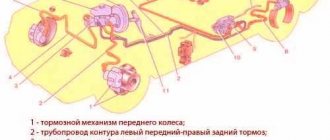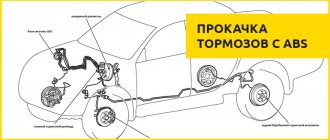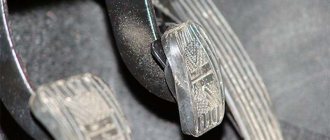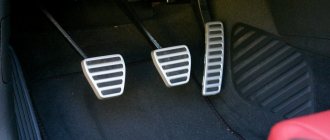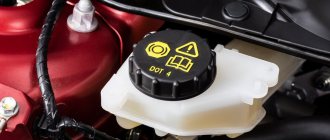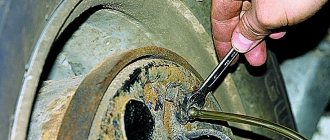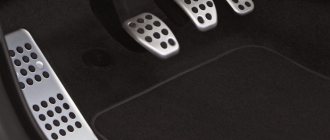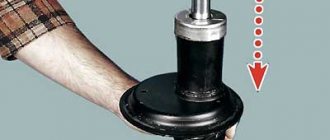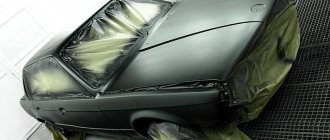ABS brakes are designed to prevent the wheels from locking during emergency braking. The main function of ABS is to regulate the speed of rotation of the car's wheels during braking. Regulation occurs due to different pressure in the brake system of each wheel.
The process is controlled by an electronic control unit, which receives signals from sensors installed on the wheels. The ECU independently decides on the required pressure at a certain moment of movement. The system's response is hundreds of times faster than the driver's fastest reaction to a given situation. Moreover, the driver can only rely on his own feelings, and not on sensor readings.
Although the ABS brake system is quite reliable, sooner or later a situation may arise when you need to bleed them. And today we will try to answer the question of how to bleed ABS brakes.
Main components of the ABS system
• Electronic control unit (ECU). This is, so to speak, the brain of the entire system, which reacts to signals coming from sensors. The ECU, having received the necessary parameters, decides what to do next and sends electronic impulses to the actuators of the brake system (control valves).
• Control valves receive signals from the ECU and generate the required pressure in the brake lines of the system.
• Sensors that measure wheel movement parameters and send them to the control unit.
Features of bleeding brakes with ABS
Bleeding ABS brakes will require the car owner to have certain skills and knowledge of the structure of his car. Without knowing where and what is located, or without the ability to read technical documentation, including drawings, you don’t even have to try to bleed the ABS brake system yourself.
Some types of brake systems cannot be pumped in a garage. Too many electronics and too fine adjustments of these electronics will not allow you to perform this operation yourself. And then there is a direct route to the appropriate service.
There are several layout systems for ABS brake systems. And each has its own pumping specifics.
If the layout of the brake system assumes that all system components are located in one block, then the bleeding technology is no different from the technology for pumping a brake system without ABS.
How to bleed ABS brakes in this case:
The system in this case is turned off by removing the fuse. Or the fuse is turned off (if so provided by the design).
Next you need to unscrew the RTC bleeder fitting. The brake system circuit is pumped when the brake pedal is pressed. Next, the car’s ignition is turned on, and the pump begins to work, which squeezes air out of the lines of the brake system circuit. After this, the fitting is screwed into place. The ABS system inoperative indicator should go out, although it should have been on before.
The following layout of the ABS brake system assumes that the system components are separated. Those. The hydraulic module with valves and the hydraulic accumulator are located in different places.
Such a system can only be diagnosed if you have a special scanning device, which is available only in specialized services.
The services perform bleeding of the brake system if the ESP or SBC systems are also installed. In a garage, it is impossible to bleed the brake systems of cars with these options. Everything there is too complicated for an inexperienced car enthusiast.
Algorithm for pumping brakes with ABS
Bleeding ABS brakes must be done by two people. First, the system is pumped on the front wheels, and then on the rear. The system of each wheel is pumped in turn.
• The connectors on the brake reservoir cap must be disconnected.
• Understand that there is a lot of pressure in the brake system. And at the first stage, this pressure needs to be reduced, i.e. almost equal to atmospheric. To do this, with the ignition off, you need to press the brake pedal about 20 times.
Types of ABS systems
- ABS includes: hydraulic valve block, hydraulic accumulator, pump (pumped in garage conditions);
- The pump, hydraulic accumulator and hydraulic valve block are located in different units; such a braking system, in addition to the ABS module, also includes additional ESP and SBC modules (pumped at a service station). It is necessary to have a diagnostic scanner to monitor the modulator valves.
Based on the features, we can conclude that before bleeding ABS brakes, decide on the type of system you have, since this instruction will only be relevant for a standard anti-lock braking system .
Scheme of work, tools and materials
Before you bleed the brakes on a Gazelle, you need to know the bleeding pattern. The operation is performed from the farthest wheel to the nearest one. Thus, work begins on the right rear wheel, then moves on to the left rear. After this, the air is removed on the right front, and then on the left. In simple words, you need to pump in a Z-shaped pattern.
What tools and materials will we need? First you need to prepare the liquid. The Gazelle is filled with the fourth class RosDot product. You will also need a 10 mm wrench to unscrew the fitting. A clean rag will also come in handy, since fluid can flow onto unnecessary areas (discs, pads). In addition, you should prepare a rubber (possibly transparent) hose that will be put on the fitting, as well as a plastic bottle with a volume of about a liter.
Anti-lock brake system (ABS) device
When braking, ABS regulates fluid pressure in the working cylinders, preventing the wheels from completely locking. Thanks to this, the braking distance is reduced and the driver continues to control the vehicle’s trajectory even during intense braking on snow, sand or wet asphalt.
The principle of operation of the abs system. Video:
The anti-lock braking system includes the following parts:
- Control block. Electronics that change pressure by opening and closing bypass valves. It analyzes information about wheel rotation. When the wheel stops, the valve partially relieves pressure and the pad presses less.
- Sensors that control rotation speed. The devices are mounted on wheel hubs and operate due to the Hall effect. They transmit information to the ECU.
- Hydraulic block. It consists of hydraulic accumulators, solenoid valves for inlet and outlet, an electrically driven pump and damping chambers.
In their normal position, the exhaust valves are closed and prevent fluid from leaving the cylinder. Accordingly, the intakes are open and do not prevent pressure from increasing when the pedal is pressed. When the car brakes, fluid enters the cylinder, increasing the pressure in it. If the wheel starts to slow down too sharply, the ECU closes the intake valve, preventing blocking. If necessary, a signal is sent to open the release valve, which reduces the pressure to a value at which the wheel is unlocked.
The need to bleed ABS brakes
However, the anti-lock braking system is now extremely common, and almost all automakers include it in the list of standard equipment, even on budget models. Therefore, skill in bleeding this type of brake system is absolutely necessary.
Anti-lock braking system is an auxiliary system, the purpose of which is to prevent the car’s wheels from locking during braking. This is achieved by changing the pressure indicators in the brake mechanisms. Its operation prevents the car from skidding during heavy braking.
The main elements of this system are:
- ECU - control unit is guided by signals received from sensors, on the basis of which it adjusts the operation of the valves;
Electronic control unit
ABS system sensors
Control valves in the ABS system
Types and types of ABS anti-lock systems
Based on the number of control circuits, there are three types of anti-lock braking systems:
- single-channel - when one wheel is blocked, all four are released;
- two-channel - triggering occurs based on data from the best (high-threshold) or worst (low-threshold) wheel;
- four-channel - each wheel is adjusted separately, which ensures maximum braking efficiency.
Important! Modern cars are equipped with four-channel systems.
Depending on the location of components and maintenance features, there are three types of ABS:
- with components (hydraulic module, valves, accumulator and pump) located in a single unit;
- with components spaced in the form of different units;
- with optional SBC and ESP systems.
Despite the complicated design, it is quite possible to replace ABS brake fluid yourself.
How to bleed ABS brakes correctly and quickly
The procedure for bleeding the brakes is influenced by the design of the system, the location of components and the presence of additional electronic modules. You need to start by relieving the pressure in the hydraulic accumulator. To do this, you need to turn off the ignition (it is not necessary to start the engine) and pump the pedal.
A simple secret to quickly pumping brakes. Video:
Read how to bleed ABS brakes and stock up on the following materials, parts, accessories and tools:
- spanner;
- a rubber (possibly plastic) hose with a diameter corresponding to the thickness of the fitting tip;
- brake fluid;
- container (necessarily transparent) into which you will drain the old brake fluid.
You cannot do without an assistant who must press the pedal on command. You will perform manipulations with the fittings that ensure the removal of liquid.
Bleeding ABS brakes, where the components are located in one unit, differs little from the standard procedure. The only thing you need to do is turn off the system by pulling the fuse. This method works on domestic Ladas.
You can take advantage of the built-in pump. Then you will have to pump with the ignition on or even with the engine running. The procedure for bleeding the brakes starts with the right front cylinder and looks like this:
- disconnect the terminal of the level control sensor fixed on the expansion tank cover;
- remove the cover;
- open the brake reservoir;
- fill the reservoir to the brim with brake fluid;
- put the hose on the tip of the fitting;
- lower the end of the hose into a container to collect liquid;
- open the fitting by turning it a quarter or half a turn;
- to activate electronic systems, turn on the ignition;
- release the brake;
- wait until the pump expels the airy mixture;
- release the brake pedal;
- Tighten the fitting with a wrench.
The brake bleeding scheme is no different on any car. First, air is removed from the “far” circuit (for “left-hand drive” cars it is on the right), then from the “near” circuit.
Important: When bleeding, keep an eye on the brake fluid level. If it falls below the minimum, the system will fill with air. Then the work has to be done again.
To bleed a system with components located in different places, a diagnostic tester is needed. It connects to the car and allows you to control electronic components using a smartphone or computer. In this case, you will also have to unscrew the fittings and drain the airy liquid. However, no manipulation of the pedal is required. Instead, the valves and electric pump must be activated using the appropriate menu items. This way you can bleed the systems on the VW Passat B6 and other modern cars.
Bleeding the brakes using the Priora as an example
Before you bleed the ABS brakes, you will have to drive the car into a pit. This will allow easy access to the fittings on the rear working cylinders and will eliminate the need to remove the discs during operation. On the Priora, the procedure for pumping brakes with ABS does not differ from that adopted on simpler models. The only difference is that the work must be performed by first turning on the ignition. In this case, the solenoid valves will be in the open position.
Bleeding the brakes on a Priora. Video:
How to Bleed Brakes on a Gazelle With ABS
How to bleed brakes on a gazelle with abs
Bleeding the hydraulic brake system
Brake fluid is poisonous. Wash any parts of your body that come in contact with the liquid with copious amounts of cold running water, and seek immediate medical attention if the liquid comes into contact with your mouth or eyes. Some types of brake fluid are flammable and may ignite if they come into contact with hot components. Take appropriate fire safety measures. Brake fluid is aggressive to paint and plastics - if it gets on such surfaces, immediately wash off the fluid with copious amounts of water. In addition, the fluid is hygroscopic (absorbs moisture from the air) - old fluid may be contaminated with water and unsuitable for use. When adding or replacing fluid into the system, use the recommended type of fluid from a freshly opened sealed container.
MODELS NOT EQUIPPED WITH ABS
Correct functioning of the hydraulic brake system is only possible if its components are free of air. To remove air from the system, bleed it.
During the bleeding procedure, add only clean, fresh brake fluid of the type specified in the Specifications. Never reuse the liquid.
If there is any doubt about the type of fluid in the system, flush the system with clean fluid and replace all seals.
If the brake fluid level has dropped in the master cylinder, find and repair the cause of the leak before continuing to operate.
Park the car on level ground (not downhill), turn off the ignition and select 1st gear or reverse. Block the wheels and release the handbrake.
Make sure that all tubes and hoses are securely attached, the couplings are tight, and the bleeder fittings are closed. Remove the dust caps and clean any dirt from the bleeder fittings.
Unscrew the brake hydraulic system reservoir cap and bring the fluid level to the “MAX” line. Replace the cap and be sure to maintain the fluid level above the “MIN” line throughout the procedure, otherwise air will re-enter the system.
There are a number of devices on sale for bleeding the brake system by one person. It is recommended to use one of these kits as they make the job much easier and also reduce the risk of escaping air and fluid being sucked back into the system. If such a device is not available, use the basic pumping method (for two people), detailed below.
If a tool is used, prepare the vehicle as described above and follow the kit manufacturer's instructions. The procedure can vary significantly depending on the type of device used, its basic procedure is also described below.
Whatever method is used, follow the correct bleeding sequence.
If components of only one of the circuits have been disconnected or removed (for example, a caliper or brake wheel cylinder), only that circuit needs bleeding.
If the entire system needs to be bled, proceed in the following sequence:
a) Rear right brake mechanism.
b) Front left brake mechanism.
c) Rear left brake mechanism.
d) Front right brake mechanism.
Pumping - the main method (for two people)
1. Prepare a clean glass reservoir and a suitable length of plastic or rubber tube that fits tightly onto the bleeder fitting. Help from a second person will be required.
2. If not already done, remove the dust cap of the bleeder fitting and place the tube prepared for bleeding onto the fitting. Immerse the other end of the tube in the brake fluid previously poured into the reservoir.
3. Make sure the master cylinder reservoir is full and keep the fluid level above the “MIN” line throughout the procedure.
4. Ask an assistant to press the brake pedal all the way several times and then keep it pressed.
5. Open the bleeder valve approximately one turn (refer to the accompanying illustration). When fluid stops flowing from the fitting, tighten it and have an assistant slowly release the pedal and check the fluid level in the master cylinder reservoir.
6. Repeat this procedure (paragraphs 4 and 5) until the leaking brake fluid is free of air bubbles. If all the fluid has drained from the master cylinder while bleeding the first brake, fill the master cylinder and bleed the brake again, taking approximately five seconds between cycles.
Content
hide
1 How to bleed the brakes
2 How to bleed brakes with ABS Audi A4, A6, Passat B5
How to bleed the brakes
How to upgrade
braking system right?
In this video I will share with you how to bleed
the brake system...
How to bleed brakes with ABS Audi A4, A6, Passat B5
How to bleed the brakes
with
ABS
You can help the channel financially. if not, add liquid to them. Quickly remove one of the master cylinder plugs (the brake pedal is held as described in the previous paragraph), connect the brake pipe and tighten the connecting nut to the torque specified in the Specifications. Repeat the procedure on the second master cylinder port, then wash off the spilled fluid.
8. Refer to the paragraphs above and completely bleed the brake hydraulic system in the above sequence.
Bleeding after disconnecting the hydraulic unit coupling
Post Views: 688
